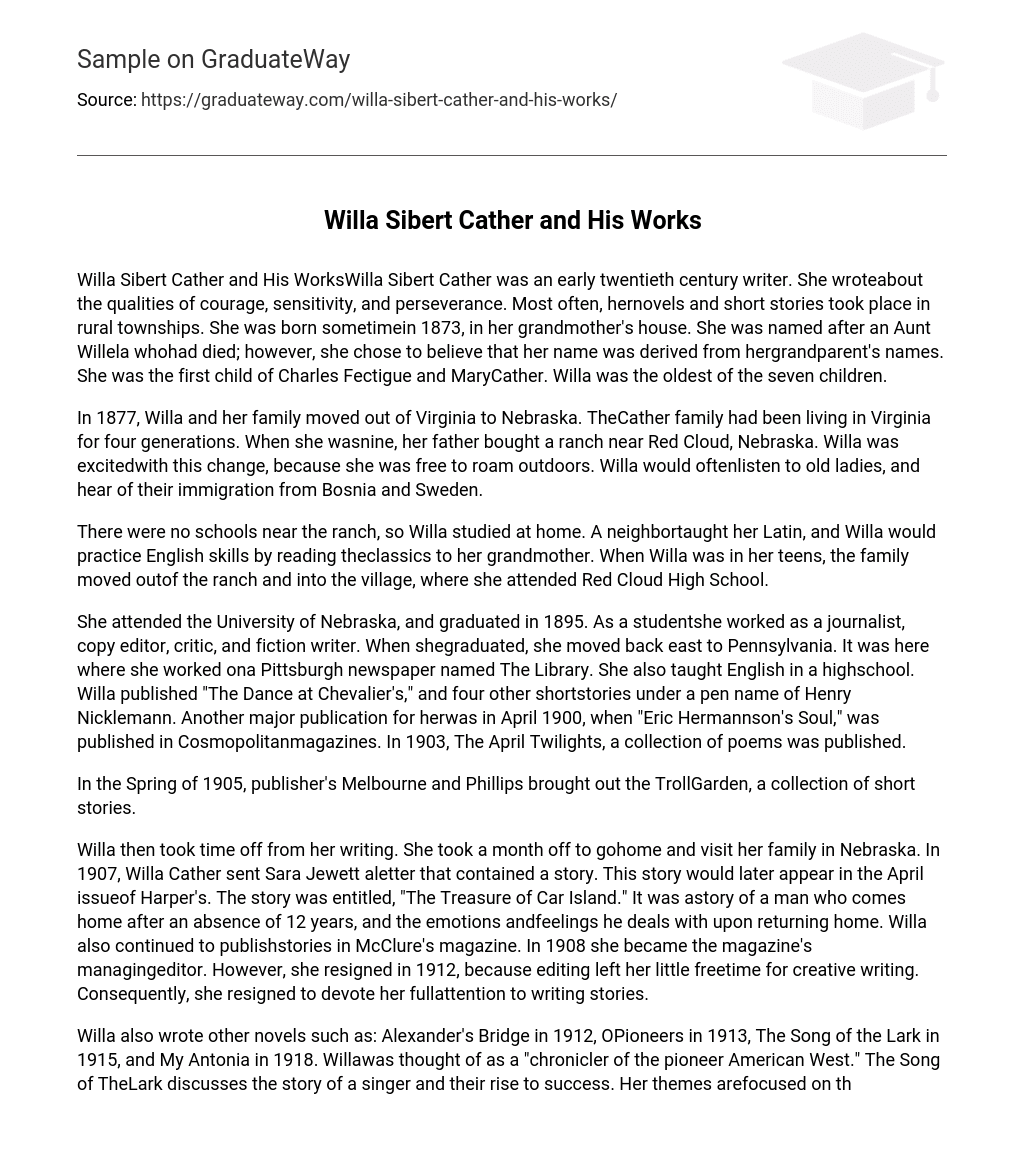Willa Sibert Cather and His WorksWilla Sibert Cather was an early twentieth century writer. She wroteabout the qualities of courage, sensitivity, and perseverance. Most often, hernovels and short stories took place in rural townships. She was born sometimein 1873, in her grandmother’s house. She was named after an Aunt Willela whohad died; however, she chose to believe that her name was derived from hergrandparent’s names. She was the first child of Charles Fectigue and MaryCather. Willa was the oldest of the seven children.
In 1877, Willa and her family moved out of Virginia to Nebraska. TheCather family had been living in Virginia for four generations. When she wasnine, her father bought a ranch near Red Cloud, Nebraska. Willa was excitedwith this change, because she was free to roam outdoors. Willa would oftenlisten to old ladies, and hear of their immigration from Bosnia and Sweden.
There were no schools near the ranch, so Willa studied at home. A neighbortaught her Latin, and Willa would practice English skills by reading theclassics to her grandmother. When Willa was in her teens, the family moved outof the ranch and into the village, where she attended Red Cloud High School.
She attended the University of Nebraska, and graduated in 1895. As a studentshe worked as a journalist, copy editor, critic, and fiction writer. When shegraduated, she moved back east to Pennsylvania. It was here where she worked ona Pittsburgh newspaper named The Library. She also taught English in a highschool. Willa published “The Dance at Chevalier’s,” and four other shortstories under a pen name of Henry Nicklemann. Another major publication for herwas in April 1900, when “Eric Hermannson’s Soul,” was published in Cosmopolitanmagazines. In 1903, The April Twilights, a collection of poems was published.
In the Spring of 1905, publisher’s Melbourne and Phillips brought out the TrollGarden, a collection of short stories.
Willa then took time off from her writing. She took a month off to gohome and visit her family in Nebraska. In 1907, Willa Cather sent Sara Jewett aletter that contained a story. This story would later appear in the April issueof Harper’s. The story was entitled, “The Treasure of Car Island.” It was astory of a man who comes home after an absence of 12 years, and the emotions andfeelings he deals with upon returning home. Willa also continued to publishstories in McClure’s magazine. In 1908 she became the magazine’s managingeditor. However, she resigned in 1912, because editing left her little freetime for creative writing. Consequently, she resigned to devote her fullattention to writing stories.
Willa also wrote other novels such as: Alexander’s Bridge in 1912, OPioneers in 1913, The Song of the Lark in 1915, and My Antonia in 1918. Willawas thought of as a “chronicler of the pioneer American West.” The Song of TheLark discusses the story of a singer and their rise to success. Her themes arefocused on the drama of the immigrant in a new land, views of personalinteraction with artwork, and the rise of civilizations in history. She nevermarried; however, she lived with friend and companion Edith Lewis for many years.
She later published other collections of short stories. These works helped herpopularity as well, works such as,”Youth of the Bright Medusa,” and,” ObscureDestinies.” It was these stories that helped her win awards. In 1923, Willawon the Academy’s Howells Medal and a Pulitzer Prize. Willa received thePulitzer Prize for One of Ours , a story of a young man who is repressed by theplains and describes his need for freedom. In May of 1944, she won the Instituteand Academy’s award.
Willa Cather was influenced and loved works such as: The Count of MonteCristo (Dumas), The Prisoner of Zenda (Hope), and Trilbus by George du Marier.
On April 24, 1947, Willa died of a cerebral hemorrhage in her apartment in ParkAvenue, however, her works still live on in the short stories and novels thatshe wrote. Willa described her writing as clean, meticulous, and she called it”demeuble,” meaning unfurnished. Willa has achieved a reputation as aconsummate artist who probed deeply into universal realities.





